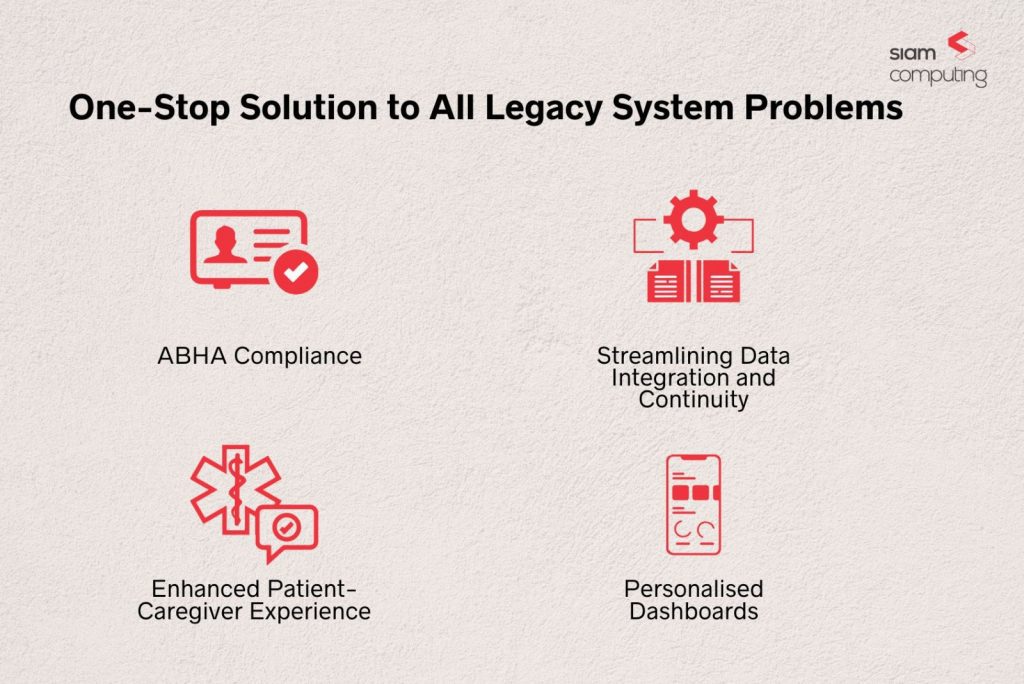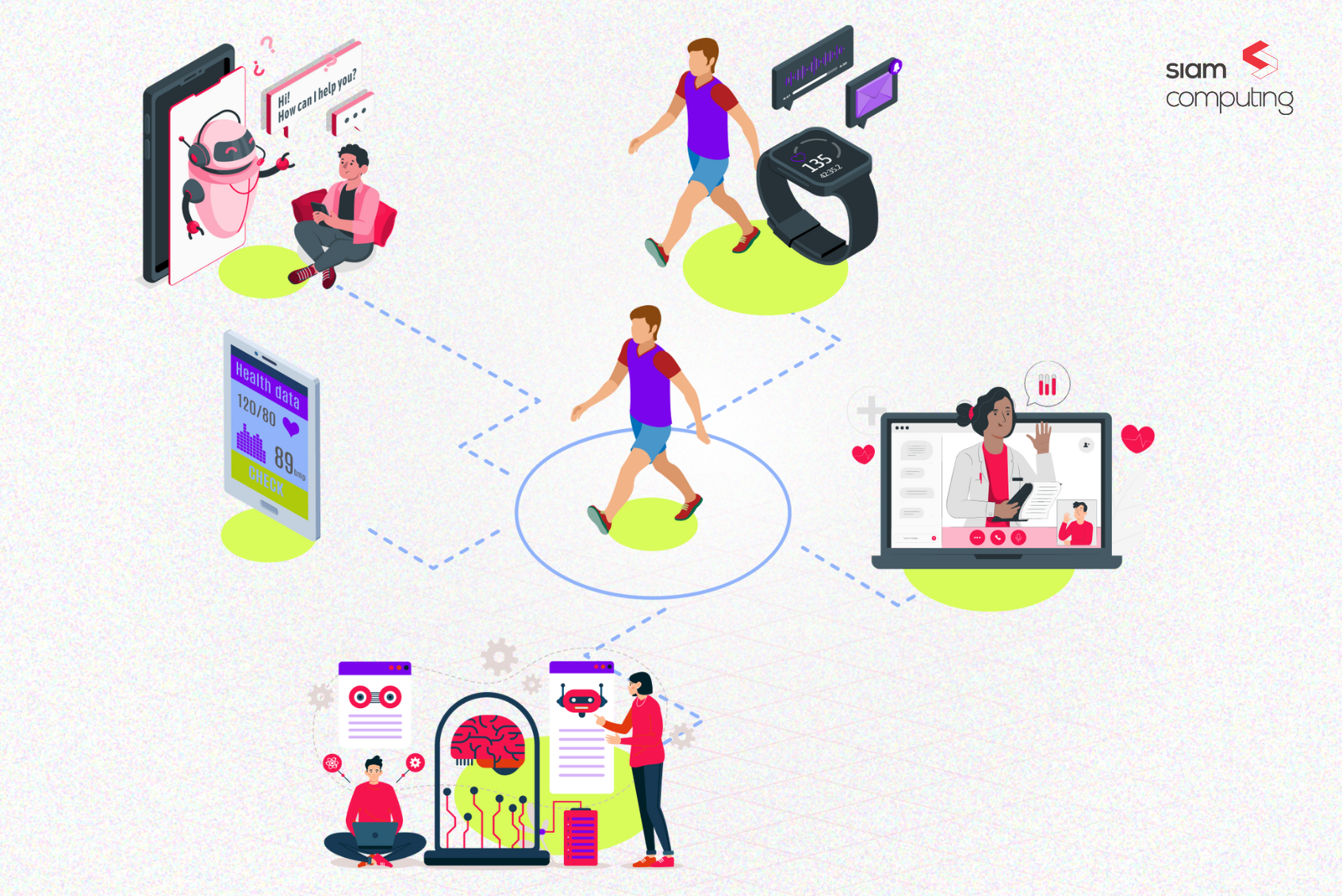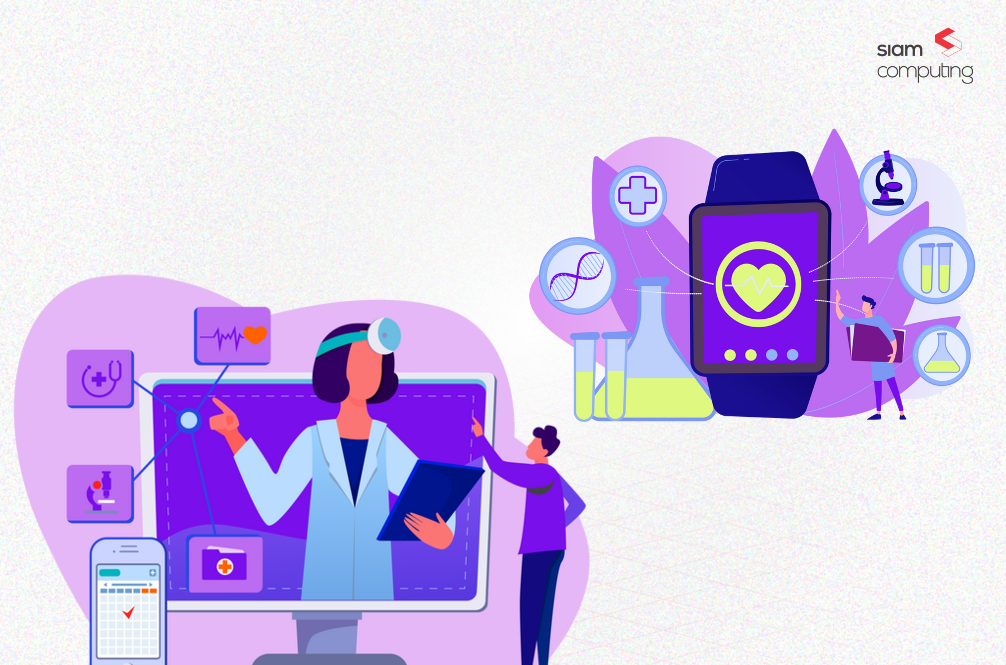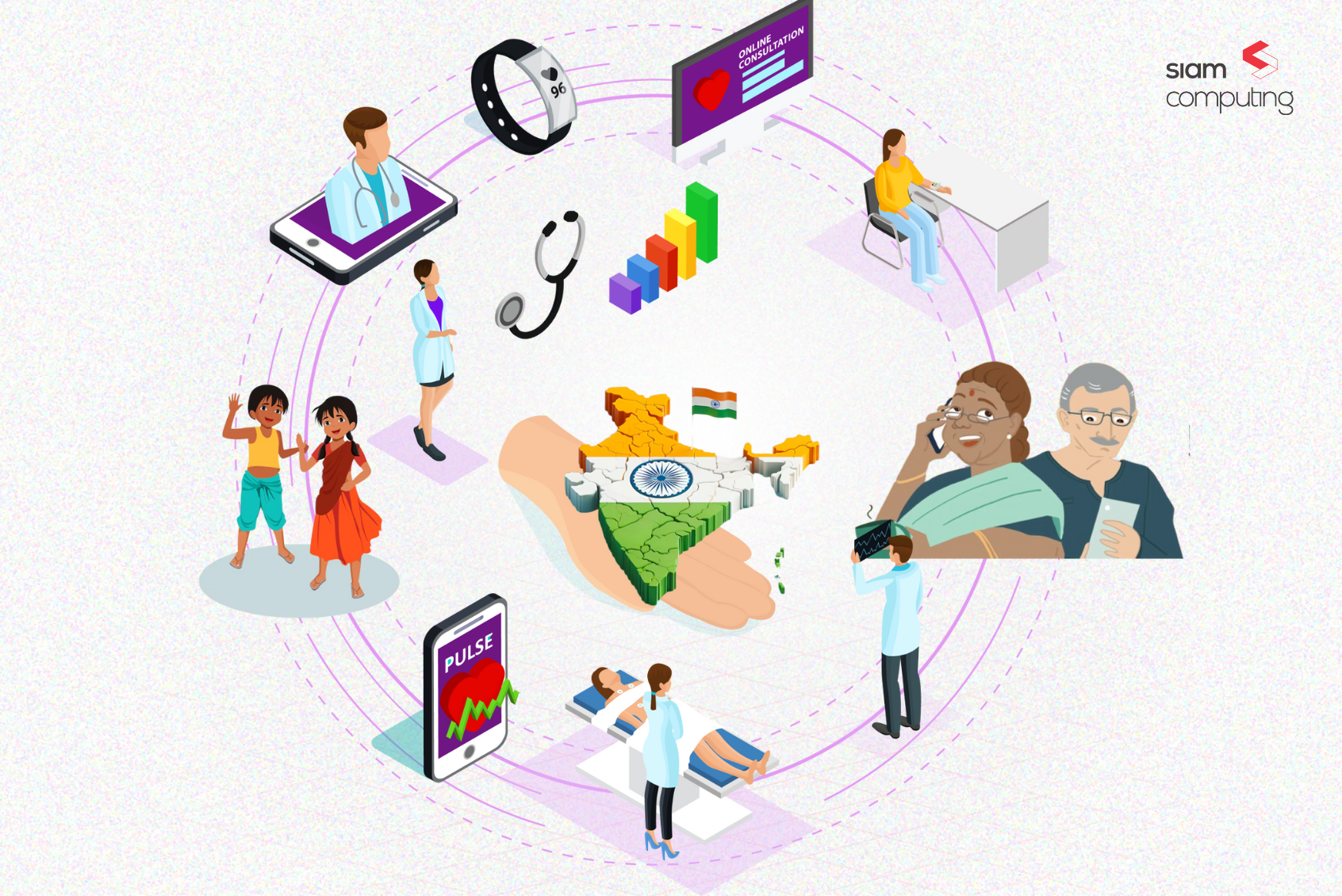In the healthcare domain, the need for innovation and advancement has to be fulfilled before it is actually felt. It is an essential prerequisite considering its absence threatens human life itself.
As far as Indian hospitals are concerned, the strive towards much-needed technological advancement is fuelled by the potential for global excellence but is constrained by legacy systems that do not stand up to the demands of modern healthcare providers.
Siam Computing has aided the quest for global excellence for leading healthcare providers by simplifying their digital transformation journeys from legacy systems. In the process, we have noticed major inefficiencies in outdated legacy systems and how they hold hospitals back from optimizing their operational processes, enhancing patient care, and gaining a competitive edge in the healthcare market.
Current Hospital Operations
Indian hospitals currently face significant limitations in delivering hassle-free patient journeys and establishing a positive hospital brand experience.
For instance, patients visiting Indian hospitals often encounter long waiting queues that extend their already stressful healthcare journey. This not only leads to patient dissatisfaction but also delays timely medical interventions. Furthermore, the reliance on inefficient data consolidation methods and disjointed hospital units hampers seamless coordination among healthcare providers, resulting in fragmented care delivery and compromised patient safety.
These problems have far-reaching implications and can be attributed to the constraints imposed by outdated legacy systems. Hospitals today find themselves caught in a cycle of reactive crisis management, failing to address the root causes of these long-standing problems. As a result, the quality of services becomes compromised, hindering the ability to proactively tackle pressing issues and impeding progress towards achieving better health outcomes.
By perpetuating this cycle, hospitals are unable to effectively recognize and address the prevailing challenges, undermining their capacity to enhance service quality and optimize patient outcomes. It is imperative for hospitals to break free from the confines of legacy systems and embrace transformative solutions to overcome these limitations, paving the way for a more efficient and patient-centric healthcare ecosystem.
Legacy Limitations

Legacy systems are the shambles of disarray in the huge jigsaw puzzle of the Indian healthcare system. Built over years of painstaking effort and expenditure, these outdated systems have ceased to deliver results.
In today’s digital age, provision for convenience and hassle-free experiences make up the basic expectation of hospital users, and by embracing technological advancements in delivering a seamless patient experience, hospitals can establish a layer of trust with the majority of the market share participants.
Discussed below are ways in which legacy systems are holding Indian hospitals back and simple solutions that new-age tech built on top of them can help hospitals deliver better patient outcomes.
1. Absence of a standard data format for ABHA implementation
The implementation of the ABHA ID, as mandated by the Indian Government, requires a unified approach to patient data collation. However, with the evolution and rapid expansion of the Indian healthcare system in the last 50 years, instances of data duplication and the creation of multiple IDs for the same patient across different locations have increased.
The duplication of patient IDs occurs mainly because each hospital resorts to its own individual ways of tracking patient data. Adding to this complexity are different units and branches of the same hospital that create different IDs for the same patient. The absence of a unique identifier for disparate patient data now presents a major challenge before Indian hospitals in the face of mandatory implementation of the ABHA ID.
2. Non-transferable Medical Records and Disjointed Care Journeys
Essentially, different parts of existing legacy systems do not talk to each other, making data transfer across hospital units and identification of inaccuracies in patient data across disparate sources impossible.
This interrupts the flow of medical records and data recovery processes and prevents healthcare professionals from obtaining a consolidated view of a patient’s health parameters. Gathering patient data across units is not just time-consuming in legacy systems but also instigates endless points of friction while aiming to provide efficient treatment plans best suited to specific health conditions.
The non-transferrable nature of health records also interferes with the smooth patient-caregiver experience and requires all stakeholders to spend more time getting records together that they would rather utilize in the interest of quality care itself. It also leads to higher treatment costs for patients.
In the absence of an interfacing layer that houses all hospital data, this fragmentation becomes worse when hospitals face HMS downtime or when their in-hospital app faces other issues.
3. Limited Scope for Preemptive Care Options
Operating under the limitations of legacy systems, the best efforts of Indian hospitals are directed only towards providing reactive care to patients.
Under the reactive care setup, there are uncertainty and doubts about following the treatment process, which leads to recurring questions due to the unquantifiable nature of risk when it comes to patient outcomes, especially for ongoing chronic care. So, the patient experiences stressful hospital interactions, which limits the hospital brand experience to just disease recovery.
Reactive care options not only question the sustainability of health narratives of a vast population like ours but also prove to be inefficient in their current form, particularly in the face of the unknown, like the recent Covid-19 pandemic.
It is in this context that a lack of preemptive care options as an essential component of the modern healthcare system makes itself felt for a society looking for ways to increase proactive self-participation in writing its own health narrative.
4. Compromised patient and caregiver experience
The offline hospital experience is now incorrectly associated with better reassurance for patients and caregivers as compared to digital-first healthcare solutions.
But in reality, the offline hospital experience is fraught with inconveniences like a lack of clarity on the next steps of treatment, time-consuming formalities that delay treatment processes, and inefficient management of current requirements in the face of ever-increasing demand for efficient support.
Besides, under these limitations, hospitals have no way of providing information linkage between patients and caregivers nor any way of making health records easily accessible.
The ones at the receiving end of these friction points are the patient’s family – the caregivers. Their inconveniences are a natural consequence of legacy systems which fail to cater to the needs of the caregiver even in an offline scenario. User experience in the offline scenario is compromised by the hospital’s inability to provide prompt care to the ones in need at the prompt time.
5. No provision for customized care options
Being future-proof is the need of the hour as we are in an age where tech solutions are transitioning towards hyper-personalisation for each user. As far as Indian hospitals are concerned, legacy systems make it impossible to segregate and present data that is relevant for each patient.
The quest for relevance is further challenging for Indian hospitals as they need to cater to multiple generations. Legacy systems necessitate patients to work their way around the entire repository of their family’s medical history when today’s users would rather pick up data most relevant for them in the interest of time and clearer action plans.
One-Stop Solution to All Legacy System Problems

In healthcare, there is no one-size-fits-all approach for answering all problems. However, a digital transformation from outdated legacy systems prepares Indian hospitals to efficiently stand up to the requirements of the modern healthcare space.
In our experience of aiding leading hospitals in their digital transformation journey, we have observed that healthcare leaders are hesitant to seek better and more modern digital solutions for their hospitals as they have had a bad experience with their legacy systems and fear that more tech leads to more complexity.
However, with our expert guidance and experience in aiding the digital transformation from legacy systems, hospitals can finally aspire to deliver the desired patient experience. Our proven process helps hospitals overcome challenges, leverage modern technology, and achieve significant improvements in patient care.
Here’s how Siam Computing helped a leading multi-speciality hospital chain in India to move out of its existing legacy solution to a modern digital-first system that optimizes its operational processes, enhances patient care, and helps them gain a competitive edge.
1. ABHA Compliance
For the purpose of unifying data for successful ABHA implementation through government-built APIs, we helped our client unify patient data across locations and units. On registering with the app, the patient’s mobile number is used to identify all records associated with them, following which data across multiple units are pulled together and shown to the patients who choose the details they are associated with.
To eliminate discrepancies in records, different parameters of records like mobile numbers, date of birth etc, are displayed before users, who get to pick up the most relevant fields for them before they merge all data.
2. Streamlining Data Integration and Continuity
Sensing the absence of a common lexicon for all interconnected systems to work on, we developed a middleware that houses data across all units and functions as the binding layer by essentially consolidating data from individual hospital units. This interfacing layer houses data from the mobile app and internal HMS and accounts for the HMS downtime by ensuring the mobile app remains fully functional.
3. Enhanced Patient-Caregiver Experience
Patient and caregiver experience for our client was taken care of by enabling patients to add their family members as caregivers and facilitating information linkage between them. Besides, we have been able to achieve efficient health record consolidation and transparency in medical records via a simple process to upload, manage prescriptions and receive timely consultations from doctors in a streamlined manner.
4. Personalised Dashboards
With regards to the relevance of data for each user, our client’s patients have access to customizable dashboards with data most relevant for each one and up-to-date with clear steps of treatment.
Final Thoughts
Legacy systems do not have the flexibility of transition, given their high maintenance requirements in terms of finance and code. It is here that modern digital-first solutions help, as they can be built on top of a hospital’s existing legacy systems, thereby eliminating the need for an expensive and painstaking migration process.
We have simplified the digital transformation for many healthcare providers and empowered them to adequately meet the demands of today and stand out for providing exceptional patient experiences. If you aspire to provide superior patient experiences, get in touch with us today and build a legacy in your domain without the shackles of an outdated legacy system.








